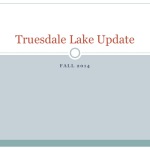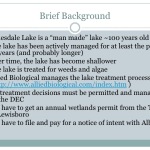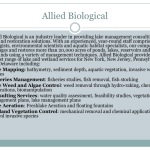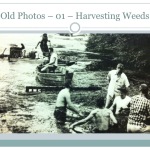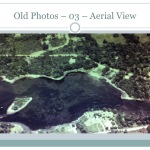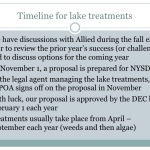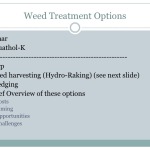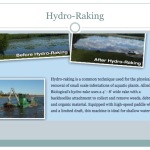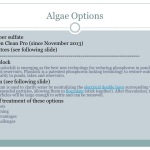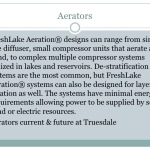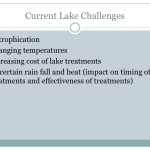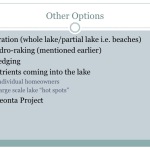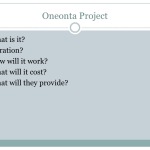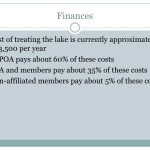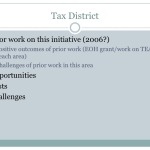On Sunday, September 21st, TLPOA President David Sachs presented the current state of our lake to a packed house at the Cyrus Russell House in Cross River, NY.
In case you missed the presentation, we have posted the slides in jpg format below and pdf format here: Lake Update 2014-09-16.
If you are interested in joining the proposed committee or helping out with time and/or expertise, please get in touch via the contact form or via joining the wonderful Nextdoor Truesdale community website and asking a question there.
In case you want to catch up on the last 15+ years of knowledge and work we have already accomplished and documented, please check this timeline of activity and studies undertaken.
(Click the images below and you can scroll through them with the left and right arrows of your keyboard.)
Truesdale Lake Update
Fall 2014
(below are the text parts of above presentation)
Brief Background
- Truesdale Lake is a “man made†lake ~100 years old
- The lake has been actively managed for at least the past 35 years (and probably longer)
- Over time, the lake has become shallower
- The lake is treated for weeds and algae
- Allied Biological manages the lake treatment process (http://www.alliedbiological.com/index.htm )
- All treatment decisions must be permitted and managed by the DEC
- We have to get an annual wetlands permit from the Town of Lewisboro
- We have to file and pay for a notice of intent with Albany
Allied Biological
- Allied Biological is an industry leader in providing lake management consulting and wetland restoration solutions. With an experienced, year-round staff comprised of biologists, environmental scientists and aquatic habitat specialists, our company manages and restores more than 20,000 acres of ponds, lakes, reservoirs and wetlands using a variety of management techniques.
- Allied Biological provides the largest range of lake and wetland services for New York, New Jersey, Pennsylvania and Delaware including:
- Lake Mapping:Â bathymetry, sediment depth, aquatic vegetation, invasive wetland species
- Fisheries Management: fisheries studies, fish removal, fish stocking
- Lake Weed and Algae Control: weed removal through hydro-raking, chemical applications, biomanipulation
- Consulting Services: water quality assessment, feasibility studies, vegetation management plans, lake management plans
- Lake Aeration: Freshlake Aeration and floating fountains
- Wetland Vegetation Control: mechanical removal and chemical applications to control invasive species
Old Photos – 01 – Harvesting Weeds (see presentation slides above)
Old Photos – 02 – Draining The Lake (see presentation slides above)
Old Photos – 03 – Aerial View (see presentation slides above)
Timeline for lake treatments
- We have discussions with Allied during the fall each year to review the prior year’s success (or challenges) and to discuss options for the coming year
- By November 1, a proposal is prepared for NYSDEC
- As the legal agent managing the lake treatments, TLPOA signs off on the proposal in November
- With luck, our proposal is approved by the DEC by February 1 each year
- Treatments usually take place from April – September each year (weeds and then algae)
Weed Treatment Options
- Sonar
- Aquathol-K
—————————————————– - Carp
- Weed harvesting (Hydro-Raking) (see next slide)
- Dredging
- Brief Overview of these options
- Costs
- Timing
- Opportunities
- Challenges
Hydro-Raking (see presentation slides above)
Algae Options
- Copper sulfate
- Green Clean Pro (since November 2013)
- Aerators (see following slide)
—————————————————————————- - Phoslock
- Phoslock® is emerging as the best new technology for reducing phosphorus in ponds, lakes and reservoirs. Phoslock is a patented phosphorus locking technology to restore water quality in ponds, lakes and reservoirs.
- Alum (see following slide)
- Alum is used to clarify water by neutralizing the electrical double layer surrounding very fine suspended particles, allowing them to flocculate (stick together). After flocculation, the particles will be large enough to settle and can be removed.
- Brief treatment of these options
- Costs
- Timing
- Advantages
- Challenges
Aerators
- FreshLake Aeration® designs can range from simple one diffuser, small compressor units that aerate a pond, to complex multiple compressor systems utilized in lakes and reservoirs. De-stratification systems are the most common, but FreshLake Aeration® systems can also be designed for layered aeration as well. The systems have minimal energy requirements allowing power to be supplied by solar, wind or electric resources.
- Aerators current & future at Truesdale
Alum
- One of the special techniques designed to limit productivity of a lake is the application of aluminum sulfate (alum). Alum works by forming a floc that strips phosphorus and suspended materials out of the water column. As it settles to the bottom, the floc impedes further phosphorus release from the sediments there. Thus, alum can effectively inactivate much of the available phosphorus in a given water body. Since phosphorus is often the limiting nutrient in algal growth, alum is therefore an effective means of limiting algal productivity. It can also greatly improve clarity in a water body since it removes the suspended materials that contribute to cloudiness.
Current Lake Challenges
- Eutrophication
- Changing temperatures
- Increasing cost of lake treatments
- Uncertain rain fall and heat (impact on timing of treatments and effectiveness of treatments)
Other Options
- Aeration (whole lake/partial lake i.e. beaches)
- Hydro-raking (mentioned earlier)
- Dredging
- Nutrients coming into the lake
- Individual homeowners
- Large scale lake “hot spotsâ€
- Oneonta Project
Aeration
- Whole lake
- Costs/Challenges
- Partial lake
- Beaches
- Individual Home Owners
- Costs/Challenges
Oneonta Project
- What is it?
- Duration?
- How will it work?
- What will it cost?
- What will they provide?
Finances
- Cost of treating the lake is currently approximately $23,500 per year
- TLPOA pays about 60% of these costs
- TEA and members pay about 35% of these costs
- Non-affiliated members pay about 5% of these costs
Tax District
- Prior work on this initiative (2006?)
- Positive outcomes of prior work (EOH grant/work on TEA beach area)
- Challenges of prior work in this area
- Opportunities
- Costs
- Challenges
Next Steps
- Reconstitute lake management committee (6?)
- 2 TLPOA Board members
- 2 TEA Board members
- 1 “unincorporated†member
- 1 “at large†member
- Mission?
- Duration?
Next Steps (2)
- Lake Management Committee Mission (?)
- To research options and determine current “best practices†for lake management (locally/NYS/nationally)
- To provide recommendations to the TLPOA and TEA boards
- To educate the Truesdale Lake community about lake management options
- To work closely with the Oneonta project (2 year duration)
- To serve as a central repository of up-to-date information about the lake and lake management procedures and policies
- Other?
Constraints
- Time – we must begin the 2015 lake treatment process by November 1, 2014 for Summer 2015
- Cost – we may find options that are appealing, but which we cannot afford
- Legal restrictions – whatever we do has to be approved by the DEC and in some cases by the US Army Corps of Engineers
- Engineering – whatever we do may require engineering plans (and therefore $$)
- Current differences in ways of raising $$ between TLPOA and TEA and non-affiliated members
Questions/Comments
- Questions/comments?
- Next steps?
- Timeline
- Commitment
- Volunteers?

